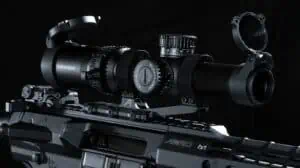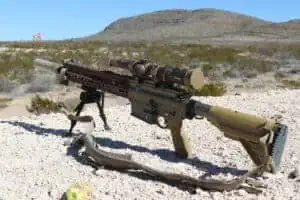Defining What Is A Scout Rifle
In the previous article in this three-part series, we briefly talked about what is a scout rifle and some of the history that helped define its place in American gun culture. The legendary firearms trainer Colonel Jeff Cooper created the scout rifle concept as a lightweight “do it all” rifle that could be used just about anywhere in the world to shoot almost anything. The specifications for a true “scout rifle” changed over the years as Cooper refined his vision of “a rifleman’s rifle.” In general, though, a scout rifle has the following features:
- Light overall weight, anywhere between 6.5 and 7.5 pounds.
- Short, handy size. Well balanced, and around a meter (40 inches) in length.
- Powerful cartridge. Something that puts out 2400 ft/lbs or more of energy at the muzzle.
- Bolt-action, with a barrel length around 19 inches.
- A lightweight stock, ideally made from polymer.
- Able to take a sling, and should be capable of 2 MOA accuracy.
- A forward mounted scope with long eye relief and backup iron sights.
All of these add up to a gun that doesn’t excel in one given area, but can do a number of different things well enough to get good results.
What Is A General Purpose Rifle
At its heart, though, the scout rifle is a smaller segment of what we would call a “general purpose rifle.” The scout rifle was designed with hunting overseas in mind, but that is not really a big factor in American gun culture right now.
Today, American gun culture has morphed into “Gun Culture 2.0.” Where Gun Culture 1.0 was all about hunting, plinking, and other rural activities, Gun Culture 2.0 is more urban. It’s more focused on self-defense and competition than it is on going out into the woods and harvesting a deer. The original specifications for the Scout Rifle were laid down before Gun Culture 2.0. This is a bit ironic, because Colonel Jeff Cooper, who laid out the parameters for the scout rifle, was also an important part of both practical shooting and firearms training. Let’s take a look, then, at some of the more recent factors that might influence a what is a scout rifle that reflects the reality of gun ownership as we know it today.
What Is A Scout Rifle, And What Is Not
One of the defining features of the scout rifle is its forward-mounted, low power scope. The original thinking behind placing the scope way out on the stock, forward of the action, is that it allows the shooter to have full field of view, and yet still be able to make a precise shot when needed. In the meantime, however, the state of the art for rifle optics has moved forward, and other options are now available.
Low Power Variable Optics
The low-power variable optic (LPVO) is a fairly recent innovation that has gained a lot of popularity in recent years. They offer many advantages for someone looking to build a general purpose, scout-style rifle. A good many of them offer a true 1 power field of view, which means that it can easily be used in close-range, snap shot situations where time is of the essence. However, with a simple twist of a dial, these scopes can reach out to 4 power, 6 power, and even up to 10 power.
These optics do have some disadvantages, though. A variable power optic has more glass inside of it than a fixed power optic. That means more weight. A Leupold FX II Scout scope, in many ways the quintessential scout optic, weighs just 7.5 ounces. Low power variable scopes, on the other hand, can weigh over twice that amount. In addition to this, the “eye box,” or space for your eye to move around behind the scope, can be quite small with an LPVO. This is especially true with the higher-power LPVOs in the 1-8 or 1-10 power range. A small eye box means that you have to place your head just right to get a good sight picture through your scope. This is not something that is normally associated with a rifle that’s designed to be handy and quick to shoot.
Red Dot Optics
Red dot optics have been around since the mid-70s, and gained acceptance with the U.S. military in 1997. There are some distinct advantages to a red dot on a scout-style rifle. The first is their light weight. Even a tough, ruggedized scope like the Aimpoint CompM4 weighs just 9 ounces, including the mount. You can mount them just about anywhere on the stock of the rifle for that true “scout rifle” look and feel. They are also very easy to use in close-in, snap shot situations.
They do, however, have a couple of drawbacks. The first is their lack of magnification. One power may be great for close-in work, but at longer distances, hitting a 10×10 plate without magnification is more challenging than with a low-power scope. The second drawback is their need to use batteries. Lose your battery power in a reticle scope (magnified or not) and all you lose is a red glowing reticle. Lose your battery power in a red dot, and you’ll quickly find out just how good your backup sights really are.
Suppressors
Suppressors, or silencers, as their inventor Hiram Maxim first called them, are not a new idea. They’ve been around for almost one hundred years, but have really grown in popularity in recent years as people have figured out their benefits. Firing off a magazine or two of full power rifle ammunition indoors is a great way to suffer permanent hearing damage. They are rapidly gaining acceptance in hunting, with more and more states allowing them to be used on a hunt.
There are drawbacks to using a suppressor, however. They are more tightly regulated than firearms are, and ownership requires a $200 tax stamp from the ATF. Suppressors are also not cheap, costing several hundreds dollars or more, even without that extra $200 sent to the .gov. Lastly, a suppressor can be quite heavy to carry around all day. This can be mitigated somewhat by using lightweight materials such as titanium in the suppressor, but that tends to raise the price even more.
Market Forces
There are other factors that have influenced what we consider to be a general purpose rifle and what is a scout rifle. Legislation such as the 1994 assault weapons ban and ongoing military actions in far-off lands have affected how we own and use rifles inside the United States. Let’s look at three items in more detail.
The Rise of the AR-15 As “America’s Rifle”
Right before the 1994 Assault Weapons Ban went into effect, you could buy a nice entry-level AR-15 for around $600. Now, over twenty five years later, you can buy a nice entry-level AR-15 for around… $600. The AR-15 and its many, many variants have taken over the semi-automatic rifle market inside the U.S.
The modular nature of the AR platform means that you can make your gun whatever you want it to be. There are accessories available that can easily turn the same AR from a close-quarters fighting machine into a long-distance precision rifle. The AR is also a popular hunting rifle, especially with predator and feral hog hunters who have little, if any, restrictions on the guns they can use to rid the countryside of noxious beasts. As we shall soon see, the AR-15’s bigger (and younger) cousin, the AR-10, is also gaining more and more acceptance in a wide variety of roles in American gun culture.
Competition
As I mentioned before, practical shooting is a big part of Gun Culture 2.0. One of the more popular of the practical shooting sports is 3 Gun, which is a fast-paced sport that involves a pistol, a shotgun and a rifle. The AR-15 in .223 dominates in the regular divisions in that sport. In the Heavy Metal division, designed for higher-powered calibers like .308 for rifle and .40 S&W (or more) for pistol, it’s the AR-10 that rules all.
The desire to win in this sport has led to a number of innovations, such as lightweight ARs that are quick to move from target to target and other modifications that are designed to reduce the weight of a rifle without affecting its reliability. 3 Gun can be brutal on firearms. It’s quite common to see empty guns tossed into storage barrels forcefully as a shooter transitions to another gun. Competitors bang guns into barriers and stage props with alarming regularity.
Another rapidly growing sport is precision rifle, which involves making precise shots from 100 yards on out to 1000 yards or more. AR-10 and AR-15 style rifles are in common use in these matches, in a variety of calibers. In many ways, the AR platform has become the default rifle for competition inside the United States.
Military
The ongoing operations overseas revealed that the military needed a rifle that could reach out to 500 yards and beyond. The 5.56mm round of the military’s M-16/M4 guns just don’t have that kind of range, so the role of Designated Marksman was created to give a rifle squad a little more long-range firepower.
It’s important to note that the Designated Marksman’s job isn’t to provide a volume of fire on the target. Rather, his role is to engage the enemy with precise shots at longer ranges. The Designated Marksman’s rifle is usually an AR-10 of some kind, in .308 caliber. He has a low-power variable optic on it, and his job is to work with his squad in order to engage targets they cannot reach with their rifles. He does not rely on the suppressive fire of his squad to accomplish his mission. Rather, he provides the suppressive fire for the squad at longer ranges than they can provide.
Wrapping It All Up
The general purpose rifle still has a big role to play inside of America’s gun culture. Next week, we’ll look at what was a scout rifle of the past, and what a scout rifle of today might look like. We’ll show how all of these items we talked about influence the features found on a general-purpose rifle that works for the members of Gun Culture 2.0.





